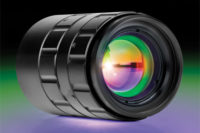ANN ARBOR, MI – The GigE Vision camera interface standard that has been used by the machine vision industry since 2006 has been updated and Version 1.1 is now available. The GigE Vision standard committee has improved the standard and Version 1.1 includes new features. Additionally, the standard – which was originally released only in English – is now also available in Japanese. The trademark process is now fully complete and the Automated Imaging Association (AIA), the global trade group that oversees the ongoing development and administration of the standard, has been issued a registered trademark for GigE Vision.
GigE Vision is a camera interface standard developed using the Gigabit Ethernet communication protocol. GigE Vision is the first standard to allow fast transfer (1000 Mbps) of data using low cost standard cables over very long lengths (up to 100 meters). With GigE Vision, hardware and software from different vendors can interoperate seamlessly over Ethernet connections. The highly scalable interface will follow the growth of Ethernet bandwidth. The GigE Vision standard committee is already preparing for incorporation of 10GigE as it becomes the mainstream protocol, allowing GigE Vision to become the fastest connection in the industry.
GigE Vision should not be confused with devices that only say they are “GigE”, while a GigE device may use Ethernet connectivity, it does not use the GigE Vision communication protocol and will not plug-and-play with GigE Vision compliant devices.
Eric Carey, chair of the GigE Vision standard committee notes, “This is the first revision of the specification since it was introduced. While not introducing new camera features itself, the subtle changes allow developers and camera manufacturers to better control internal processes thus allowing for more full-feature camera options.”
Among the many changes, clarifications and improved documentation are several new features including new pixel formats and Bayer format support; improved error handling; support for multiple versions of the GenICam schema and GenAPI; and new commands allowing action commands to be sent to multiple devices simultaneously as well as managing the execution time.
“We’re glad to see the widespread market acceptance of GigE Vision,” says Jeff Fryman, AIA’s director of standards. “The end users in our industry have really accepted the plug-and-play aspect of the standard; it definitely saves time and frustration on a project. Overall, standards allow the industry component manufacturers to bring exciting new products to market faster, accelerating the technology improvements in industry. With less time and money spent on multi-vendor integration steps, more focus can be placed on technology innovation, it’s a real win-win for the industry,” adds Fryman.
“While all that work was going on to upgrade the standard, the AIA was steadily progressing in our trademark registration process,” says Dana Whalls, AIA’s managing director. “We have now received our Registered Trademark for GigE Vision and you’ll now see GigE Vision used in industry with a circle-R designation,” she added. One other notable improvement for the GigE Vision standard is that Version 1.1 is now available in Japanese, in addition to English, which will better serve the large manufacturing and user base for machine vision in Japan.
“Since the standard’s adoption in 2006, GigE Vision cameras increased 6-fold in units sold and over 5-fold in sales revenue. This represents a meteoric rise in acceptance, leaving little doubt of the growing importance of GigE Vision,” says Paul Kellett, AIA’s director of market analysis.
The standard was developed for the industry with the talent and commitment of a group of companies representing every sector of the vision industry. More information is available on the GigE Vision web pages of Machine Vision Online (www.machinevisiononline.org). Included is a listing of registered GigE Vision compliant products which will make it easy for users to find the product that best suits their needs and provides the additional benefit of knowing that these compliant products have been tested and will easily interoperate with each other. The AIA tests the compliancy of registered products in cities across the globe throughout the year. Purchasers of vision equipment are encouraged to look for the GigE Vision Logo for assurance that a product is compliant – only registered compliant products may use the logo. To be sure, they may check the listing of compliant products on the website as they get updated frequently.
The GigE Vision standard is not an open source standard and may be obtained from the AIA. Anyone interested in more information on may contact Jeff Fryman at (734) 994-6088 or e-mail [email protected].
GigE Vision Version 1.1 Interface Standard Released
Looking for a reprint of this article?
From high-res PDFs to custom plaques, order your copy today!



